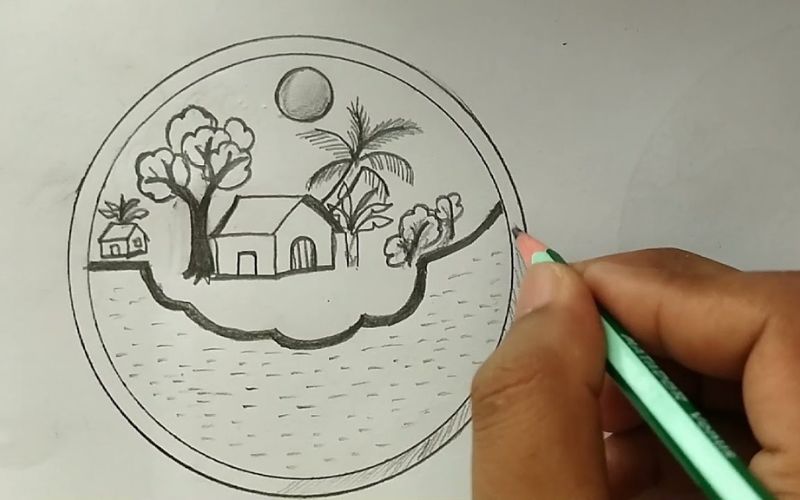Drawing is one of the most ancient forms of human expression. From the cave paintings of early humans to the intricate masterpieces of the Renaissance, drawing has been a vital means of communication and creativity. However, many people shy away from drawing, believing it requires an inherent talent or years of practice. The truth is, drawing can be accessible to everyone, and with a few simple techniques, anyone can create beautiful and expressive art. This article will explore various easy drawing techniques and tips to help you get started on your creative journey.
Understanding the Basics
Before diving into specific techniques, it’s important to understand some basic principles of drawing. These fundamentals will serve as the foundation for your artistic endeavors.
- Lines and Shapes: At its core, drawing is about creating lines and shapes. Start by practicing basic shapes like circles, squares, and triangles. These simple forms can be combined and manipulated to create more complex images.
- Light and Shadow: Understanding how light interacts with objects is crucial for creating depth and realism in your drawings. Practice shading techniques to depict light and shadow, giving your drawings a three-dimensional quality.
- Perspective: Perspective is the technique used to represent three-dimensional objects on a two-dimensional surface. Learning one-point and two-point perspective will help you create more realistic and proportionate drawings.
- Proportions: Keeping the proportions of objects and figures correct is essential for realistic drawing. Practice sketching the human figure and other objects with a focus on maintaining accurate proportions.
Simple Drawing Techniques
Now that you have a grasp of the basics, let’s explore some simple drawing techniques that can help you create impressive artwork with ease.
1. Doodling and Zentangle
Doodling is a fun and stress-free way to start drawing. It involves creating simple, repetitive patterns and shapes without worrying about the final outcome. Zentangle is a structured form of doodling that uses repetitive patterns to create intricate designs. Both techniques are great for relaxation and can help you develop your drawing skills.
- Start with Basic Shapes: Begin by drawing simple shapes like circles, squares, and triangles. Fill these shapes with different patterns such as lines, dots, and spirals.
- Experiment with Patterns: Explore various patterns and textures. Try combining different patterns within a single shape to create complex designs.
- Use a Fine-Tip Pen: For more intricate details, use a fine-tip pen or marker. This will allow you to create precise lines and add depth to your doodles.
2. Contour Drawing
Contour drawing focuses on capturing the outline and edges of an object. This technique helps improve hand-eye coordination and trains you to observe details more closely.
- Blind Contour Drawing: Without looking at your paper, outline an object in one continuous line. This exercise forces you to focus on the object’s shape and details.
- Modified Contour Drawing: Similar to blind contour drawing, but you can occasionally glance at your paper. This technique allows for more accuracy while still emphasizing observation.
3. Grid Drawing
Grid drawing is a method that involves using a grid to break down a complex image into smaller, more manageable sections. This technique helps with accuracy and proportion.
- Create a Grid: Draw a grid on your reference image and your drawing paper. Ensure both grids have the same number of squares.
- Transfer the Image: Focus on one square at a time, transferring the contents of each square from the reference image to your drawing paper. This method simplifies the drawing process and ensures accurate proportions.
4. Negative Space Drawing
Negative space drawing involves focusing on the spaces around and between objects rather than the objects themselves. This technique helps improve composition and the ability to see shapes more abstractly.
- Identify Negative Spaces: Look at the spaces between and around the objects in your composition. These spaces are the negative spaces.
- Draw the Negative Spaces: Instead of drawing the objects, draw the shapes of the negative spaces. This will help you create more accurate and balanced compositions.
Drawing Tools and Materials
Having the right tools and materials can enhance your drawing experience and improve the quality of your artwork. Here are some essential drawing supplies to consider:
- Pencils: Start with a range of pencils from H (hard) to B (soft). Hard pencils create lighter lines, while soft pencils produce darker, more expressive lines.
- Erasers: Invest in a good quality eraser, such as a kneaded eraser for lightening areas and a precision eraser for detailed work.
- Paper: Use different types of paper for different effects. Smooth paper is ideal for detailed work, while textured paper adds depth and character to your drawings.
- Pens and Markers: Fine-tip pens and markers are great for adding details and creating bold lines.
- Blending Tools: Blending stumps and tortillons help create smooth transitions between light and shadow.
Practicing Regularly
Like any skill, drawing improves with practice. Set aside time each day to draw, even if it’s just for a few minutes. Consistent practice will help you develop your skills and build confidence in your abilities.
- Keep a Sketchbook: Carry a sketchbook with you to capture ideas and practice drawing on the go. Sketching regularly will help you develop a habit of drawing and improve your observation skills.
- Draw from Life: Practice drawing objects and scenes from real life. Observing and drawing from life enhances your ability to capture details and proportions accurately.
- Join a Drawing Group: Joining a local or online drawing group can provide motivation and inspiration. Sharing your work with others and receiving feedback can help you grow as an artist.
Overcoming Common Challenges
As you embark on your drawing journey, you may encounter some common challenges. Here are a few tips to help you overcome them:
1. Fear of Making Mistakes
Many beginners fear making mistakes and feel discouraged when their drawings don’t turn out as expected. Remember that mistakes are a natural part of the learning process. Embrace them as opportunities to learn and improve.
- Use Light Lines: Start with light, tentative lines that can be easily erased or adjusted.
- Focus on Progress: Instead of striving for perfection, focus on the progress you’re making. Celebrate small improvements and milestones.
2. Lack of Inspiration
Finding inspiration can be challenging, especially when you’re just starting. Look for inspiration in your surroundings, nature, and everyday objects.
- Keep an Inspiration Folder: Collect images, photographs, and artwork that inspire you. Refer to this folder whenever you’re feeling stuck.
- Try Different Subjects: Experiment with drawing different subjects, such as landscapes, portraits, animals, and still life. This variety can spark new ideas and keep your practice interesting.
3. Comparing Yourself to Others
It’s easy to compare your work to that of more experienced artists and feel discouraged. Remember that every artist has their own unique style and journey.
- Focus on Your Growth: Concentrate on your own progress and improvement rather than comparing yourself to others.
- Learn from Others: Instead of feeling discouraged, use the work of other artists as a source of inspiration and learning. Analyze their techniques and incorporate what you like into your own practice.
Final Thoughts
Drawing is a rewarding and accessible form of creative expression that anyone can enjoy. By understanding the basics, exploring simple techniques, and practicing regularly, you can develop your drawing skills and create beautiful artwork. Remember that the key to improvement is patience and persistence. Embrace the process, enjoy the journey, and let your creativity flourish.
So, pick up a pencil, find a comfortable spot, and start drawing. Whether you’re doodling in a notebook, sketching a landscape, or creating intricate designs, each stroke of the pencil brings you closer to unlocking your artistic potential. Happy drawing!



